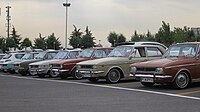Paykan
- 1967–2005 (sedan models)
- 1967-2015 (pickup models)
5-door Estate
2-door Coupe utility (Pick up)
IKCO Arisun
- 1725 cc I4 (from the Hunter)
- 1598 cc, 65 hp I4 (from the Avenger)
- 1796 cc I4 PSA XM 8-valve engine
3-speed automatic

The Paykan (Persian: پيکان, romanized: Peykân meaning Arrow), is the first Iranian-made car produced by Iran Khodro between 1967 and 2005. The car, formerly called "Iran National", is a licensed version of the British Rootes Arrow (Hillman Hunter) and was very popular in Iran from its introduction until its discontinuation.
The Paykan spawned some locally developed variants, most notably a pickup named Bardo and having a different body shell from the one sold elsewhere.
History

The design was introduced to Iran by Mahmoud Khayami, co-founder and, by then, owner of the Iran Khodro (formerly called "Iran National") company and factory, who accurately predicted that Iran was in need of a simple "no-frills" motorcar within the price range of ordinary people.[citation needed]
The car itself originated in 1966 as the "Arrow" series of vehicles (the most prolific version of which was badged as the Hillman Hunter); designed and manufactured by the Rootes Group, which was the British wing of Chrysler Europe. In 1967, Rootes began exporting Hillman Hunters to Iran Khodro in "complete knock down" (CKD) kit form, for assembly in Iran. By the mid-1970s, full-scale manufacturing of the car (minus the engine) had started in Iran.
In 1977, Roy Axe designed a new Paykan facelift model using many interior and exterior parts from the Chrysler Alpine.
In 1978, PSA Peugeot Citroën purchased the ailing Chrysler Europe after Chrysler exited the European market; and with it acquired the rights to the Hillman Hunter/Arrow design. A year later, Peugeot ended Hillman Hunter production in Ireland. Following this, the Paykan's engine production tooling was moved to Iran and was in full-scale manufacturing under Peugeot licence. This ended in 2005 with the final Paykan leaving the assembly line.
Iran Khodro tried to replace Paykan with a so-called "New Paykan" but Peugeot did not agree with the naming. This revealed the fact that the intellectual ownership of the Paykan brand and logo still belongs to PSA Peugeot Citroën, as a legacy of Rootes Group.
Design
Although the Paykan was based on a 1966 Hillman Hunter, there were many changes and modifications made to it over the years – notably the substitution of the original 1725cc Rootes engine with a Peugeot 504-derived unit. The modifications to the exterior included revised headlights and taillights. A Paykan Pickup was also offered.[1] There was another pickup truck based on the Hillman Hunter sold in South Africa – the Dodge Husky – but the two models used different bodies. The South African version has a thicker B-pillar and retains the saloon's lines along the side panels. The tailgate and rear window are also subtly different.
The Iranian government reportedly offered Iran Khodro a large cash incentive to end Paykan production by 2005, labelling the car as an environmental hazard because of its unacceptably high fuel consumption. During its last years, the order backlog was nearly two years long.[citation needed]
The Samand, commonly referred to as the "New Paykan", is currently being produced by Iran Khodro as a modern substitute for the Paykan class of cars. In 2005, Iran Khodro announced that it had sold the discontinued Paykan's motorcar production line to the Khartoum Transport Company in Sudan, while car-parts production for the Paykan still continues by third-party manufacturers in Iran.
- A 1960s Paykan seen in Tehran.
- A 1971 Paykan DeLuxe.
-
 A Paykan gathering in Northern Tehran.
A Paykan gathering in Northern Tehran. -
 A Paykan Pickup (Bardo IKCO).
A Paykan Pickup (Bardo IKCO).
Legacy

Despite the vehicle being fully discontinued in 2015, the Paykan still left its mark on the Iranian automotive industry. The Peugeot ROA, which is still offered , shares the Paykan chassis, although its bodyshell is from Peugeot 405. A similar vehicle based on the Paykan chassis is also produced under the IKCO Arisun name, although it is stylistically based on Peugeot 405.[citation needed]
The PaykanArtCar art project, started in 2021, use a Paykan as a "canvas".[2]
See also
References
- ^ "Iran Khodro Paykan Pick up, tocmp.org". Archived from the original on 2016-04-15. Retrieved 15 February 2016.
- ^ Berk, Brett (1 November 2021). "To Protest Iran's Anti-Gay Abuses, an Artist Painted a Dictator's Car". The New York Times. Retrieved 25 November 2022.
External links

- Iran Khodro Industrial Group
- Paykan history
- News story: Iranian car hits end of the road
- v
- t
- e
| Type | 1960s | 1970s | 1980s | 1990s | 2000s | 2010s | 2020s | ||||||||||||||||||||||||||||||||||||||||||||||||
| 7 | 8 | 9 | 0 | 1 | 2 | 3 | 4 | 5 | 6 | 7 | 8 | 9 | 0 | 1 | 2 | 3 | 4 | 5 | 6 | 7 | 8 | 9 | 0 | 1 | 2 | 3 | 4 | 5 | 6 | 7 | 8 | 9 | 0 | 1 | 2 | 3 | 4 | 5 | 6 | 7 | 8 | 9 | 0 | 1 | 2 | 3 | 4 | 5 | 6 | 7 | 8 | 9 | 0 | 1 | |
| Compact car | Runna | ||||||||||||||||||||||||||||||||||||||||||||||||||||||
| Tara | |||||||||||||||||||||||||||||||||||||||||||||||||||||||
| Mid-size | Paykan | ||||||||||||||||||||||||||||||||||||||||||||||||||||||
| Large family | Peugeot Pars | ||||||||||||||||||||||||||||||||||||||||||||||||||||||
| Samand | |||||||||||||||||||||||||||||||||||||||||||||||||||||||
| Samand LX | |||||||||||||||||||||||||||||||||||||||||||||||||||||||
| Samand Soren | |||||||||||||||||||||||||||||||||||||||||||||||||||||||
| Dena | |||||||||||||||||||||||||||||||||||||||||||||||||||||||
| Dena Plus | |||||||||||||||||||||||||||||||||||||||||||||||||||||||
| Executive | Samand Sarir | ||||||||||||||||||||||||||||||||||||||||||||||||||||||















